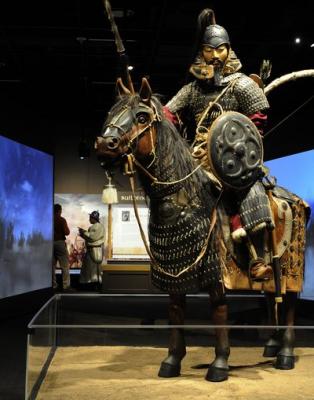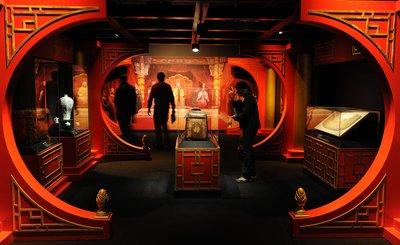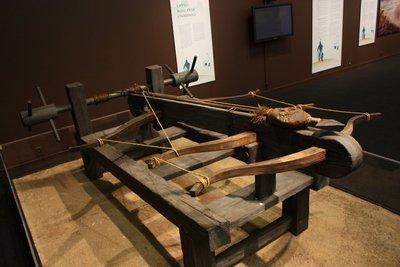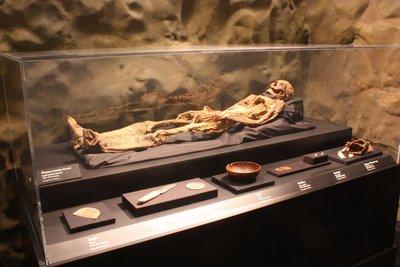
When Don Lessem - the organizer of "Genghis Khan: The Exhibition," which opens Saturday at the Tech Museum - first traveled to Mongolia in the late 1980s, he had the Western view of Genghis. But then, he says, "I saw all these glowing descriptions of him and all the statues to him and thought, 'Why?' Because I had this impression of him as a bloodthirsty villain. Then the Mongolian people set me straight, and I came away thinking, 'This guy is incredible.' "
In fact, says William Fitzhugh of the Smithsonian Institution's Arctic Studies Center, Genghis was an extraordinary ruler whose historical legacy needs to be reassessed in the West.

It is the accomplishments of this "other Genghis" - as well as the achievements of his sons and grandsons - that are at the heart of the show, which recently drew 175,000 visitors during a three-month run at the Denver Museum of Nature & Science. In the exhibit, which will take up 14,000 square feet in Parkside Hall adjacent to the Tech, there is an array of artifacts, many of which have never previously left Mongolia, and elaborate re-creations of Mongolian life during Genghis' time.
"We're always trying to mirror Silicon Valley," says Elizabeth Williams, vice-president of marketing for the Tech. "Each of the big exhibitions we've had here - 'The Human Body,' 'Leonardo,' 'Star Trek' - have had that spirit of Silicon Valley, innovative, global impact component. It also dovetails nicely with the technology piece, because similar to what Leonardo was doing back in his day, Genghis Khan had some similar impact in terms of the warfare technology. And I think it has that educational component that we're always looking for as well."
Genghis Khan was born around 1162 into one of the many nomadic tribes that roamed what is now Mongolia. He was illiterate and was born into a hard life. But by 1206, he had united all the warring Mongolian factions. Before his death in 1227, "in the space of just two decades, he was able to set the foundation of the Mongol Empire, which then rolled on until long after he died," Fitzhugh notes.

Genghis "wanted to be a benevolent ruler of a civilized world," Lessem says. "Once you were in the pale of the empire, it was a wonderful place to live - for the time."
For one thing, Fitzhugh says, Genghis displayed a religious tolerance uncommon in that era. "He allowed all faiths to be represented in Karakorum, the capital city. There were at least 15 religious temples in the city. There were Hindus, Buddhists and Shamanists and Christians of various types. In fact, the Christians were quite powerful."
Another aspect of his rule was a reliance on a meritocracy, "which was a real breakthrough because - up until that time - the leaders, the generals, had always been picked on the basis of clan affiliation," Fitzhugh says. "All that meant was that everybody fought with everybody. So he broke down all those clans and set up a military that - although it was controlled by the central government - was an army where all the general and officers were chosen on the basis of performance and loyalty.

While there have been museum exhibits about Genghis' time in the past, Lessem notes that "they all basically just used his name and included very few pieces from the period.
"So I went to the Mongolian government, and because they are such a small country, they were willing to let a private exhibit person work with them and try to mount an exhibition. They knew I cared about the subject, and they thought I would treat it right. So they were willing to loan me just about anything they had from his time."
Although Fitzhugh notes that "there's hardly anything that is known to have been owned by Genghis or that his hand touched," Lessem and his consultants were able to assemble close to 250 artifacts drawn from Mongolia's Archaeology Institute, five Mongolian museums, private collectors and - in the case of an 800-year-old mummy - the Smithsonian. They include shamans' costumes, elaborately woven silk robes, finely crafted gold bracelets and beautifully detailed swords, saddles and armor from the period.

The exhibition has 10 videos on aspects of life at the time, giant video maps, interactive (and kid-friendly) games and one exhibit that gives you the sense of being caught in the middle of a herd of horses. There are replicas of tribal villages and such war technology as a trebuchet, a siege engine designed by Chinese engineers that the Mongolians incorporated into their armies.
Each visitor's ticket has a representation of one of five or six different people who would have lived during the time of the empire, and in each room, there are computers where you can go and see what happens to that person over the course of time.
In addition, "we have a whole bunch of demonstrators showing how the villages were set up and letting you fire a catapult," Lessem says. "You get to put on Mongolian-style robes, and what I really like is that we have live entertainment every day for a couple of hours. The same traditions of dance and music that were around then are still around now - which is wonderful."
Fitzhugh predicts that those who visit the exhibit will not only come away with just a very different view of Genghis Khan but also of "ancient history in Asia, something Americans generally don't know very much about.
"That's the central thrust of the exhibit: Let's familiarize Americans with a particular period of Mongol history from a time when Mongol and Asian history changed the world."



Reader Comments
to our Newsletter